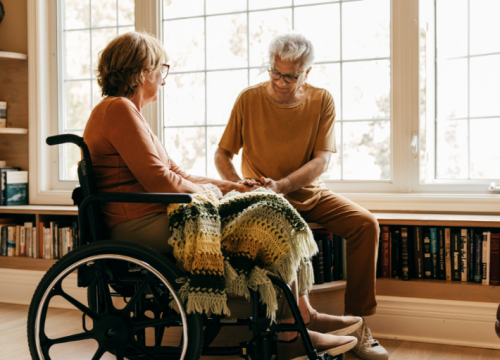La enfermedad de Parkinson es conocida principalmente como un trastorno que afecta el movimiento. Sin embargo, para algunas personas con Parkinson (PWP, por sus siglas en inglés), existen otros síntomas discapacitadores de la enfermedad. Sobrellevar la demencia, incluidas las dificultades con la memoria y la lentitud en el pensamiento o la comunicación, es un reto tanto para las personas con Parkinson como para los cuidadores. Reconocer los signos y diseñar las estrategias para sobrellevarla podrían incrementar el nivel de funcionalidad de las estas personas así como su autoestima.
Así pues, aunque el tema de este artículo ciertamente no atañerá a todos nuestros lectores, esperamos que pueda ser de utilidad para quienes se vean enfrentados ahora o en el futuro con estos síntomas, así como para aquellos que se dedican a su cuidado.
En principio, es importante entender que los lapsos de memoria, la confusión y la lentitud en la comunicación, pueden deberse a una variedad de problemas tales como el estrés, los medicamentos o la depresión. Por consiguiente, los pacientes que experimentan tales problemas deben tratar de analizarlos con sus médicos antes de precipitarse a conclusiones acerca de sus dificultades para pensar.
Al hablar de la demencia, se suele pensar en la enfermedad de Alzheimer, en la cual las personas experimentan problemas con la memoria, pero también pueden tener trastornos como dificultades del habla o problemas para planificar y llevar a cabo las labores diarias. De hecho, la demencia en las personas con Parkinson puede deberse a una enfermedad de Alzheimer coexistente. Sin embargo, la demencia en el Parkinson puede adquirir una forma un poco diferente y suele presentarse como un conjunto de retos completamente distintos.
Además de volverse olvidadizas, las personas pueden ver que sus procesos de pensamiento son más lentos y pueden tardar bastante tiempo en responder a una pregunta. Puede haber dificultad para concentrarse y una particular falta de impulso o iniciativa, lo que hace que los cuidadores se quejen de la pasividad en las personas con Parkinson. El procesamiento visuoespacial también puede disminuirse, lo que podría llevar a dificultades con las labores diarias desde conducir, vestirse o aun insertarse un audífono en la oreja.
Una parte importante de cualquier conversación con el médico es, en primer lugar, evaluar cómo los medicamentos pueden contribuir a sus síntomas y tomar las medidas necesarias para simplificar el régimen de tratamiento, eliminando aquellos medicamentos que pudieran empeorar las dificultades para pensar, tales como los anticolinérgicos o los sedantes. Más aun, las personas con Parkinson con demencia pueden ser particularmente propensas a la confusión y las alucinaciones como efecto secundario de los medicamentos utilizados para tratar la enfermedad.
En segundo lugar, es importante distinguir la demencia de la depresión. La depresión a veces puede llevar a la lentitud en las respuestas y problemas para concentrarse, o la tendencia a ser olvidadizo, pero si se reconoce a tiempo, responde al tratamiento.
En tercer lugar, actualmente hay una variedad de opciones de tratamiento que pueden mejorar la memoria y en general las habilidades cognitivas, las cuales pueden ser analizadas con el médico.
Es importante mencionar que hay una serie de cambios que pueden hacerse para ayudar a las personas con Parkinson a sobrellevar tales dificultades. Mantener una vida simple es la mejor manera de asegurar que la persona pueda continuar participando en las actividades normales tan plenamente como sea factible, y mantener cierto grado de independencia el mayor tiempo posible.
Por ejemplo, para ayudar a superar la lentitud de pensamiento, en vez de comunicarse con la rapidez “normal”, hay que tratar de establecer contacto visual y disminuir la rapidez con la que habla, para cerciorarse de que la persona con Parkinson sea capaz de procesar todo lo que usted dice. Deje un buen tiempo para la respuesta y evite interrumpir o terminarle las frases. Trate de no hacer preguntas abiertas como “¿qué te gustaría tomar en el desayuno?”. Más bien, ofrezca ejemplos y elecciones con preguntas cerradas como “¿quieres café?”. Las respuestas de “sí” o “no” son fáciles de comunicar, ya sea verbalmente o asintiendo con la cabeza. Un entorno hogareño simplificado puede reducir el riesgo de confusión. Retirar el desorden acumulado y los muebles innecesarios o los utensilios y aparatos de cocina de poco uso es una manera de hacer esto. Otra es quitando los artículos que usted no quiere que la persona con Parkinson use.
Esto incluye las licuadoras, los procesadores de alimentos y los cuchillos afilados en la cocina, las escaleras y escalerillas, y las herramientas en el garaje o el sótano. Los medicamentos pueden ser guardados bajo llave si están en riesgo de que la persona con Parkinson se confunda con las dosis.
Todos sabemos la importancia de mantener un régimen regular de ejercicio. Igualmente, los ejercicios y las actividades mentales son importantes para mantener la agilidad del pensamiento. Los ejercicios pueden incluir hacer crucigramas o rompecabezas, los juegos de naipes, leer o escuchar música, mantener un diario (el cual puede también ayudar a la memoria al ser repasado) y continuar con los pasatiempos favoritos.
La actividad física también puede incorporarse, por ejemplo, los ejercicios al ritmo de la música o el baile. De nuevo, es importante tener en cuenta que estas tareas pueden tomar mucho más tiempo llevarse a cabo y aquí, paciencia, es la palabra clave.
Para los pacientes que pueden tener dificultades recordando la secuencia de los pasos a seguir para llevar a cabo una tarea en particular, es conveniente hacer un listado en letras grandes o demostrar cada paso de tal manera que la persona con Parkinson pueda imitarlos y seguirlos. Una lista de “cosas por hacer” podría ser muy útil. Por ejemplo, por la mañana pegar en el baño una lista, la cual, dependiendo de las habilidades y limitaciones del paciente, puede incluir:
RUTINA MAÑANERA
- Cepillarse el cabello
- Cepillarse los dientes
- Usar el inodoro
- Lavarse las manos
- Apagar la luz al salir
Cada uno de los pasos de la lista debe ser tan simple y claro como sea necesario. Recuerde que estas listas pueden tener que ser más detalladas con el paso del tiempo. Realizar las actividades de la vida diaria en el mismo orden cada día proporciona estructura y minimiza la confusión.
Colocar un calendario grande en un lugar común (como la cocina o al lado de la cama), marcando las citas o los eventos de cada día, es otra manera de ayudar a las personas con Parkinson a ser más independientes. Éste podría revisarse diariamente junto con un listado de tareas para el día.
Otro aspecto importante a tener en cuenta es el acto de vestirse. El mensaje aquí es mantenerlo tan simple como sea posible. Haga que la persona con Parkinson use prendas fáciles de poner y quitar, con cremalleras o solo unos pocos botones por delante o cierres de Velcro. Distribuya o haga una pila con las prendas en el orden en que deben ponerse, con la ropa interior y las medias en primer lugar. Si el paciente insiste en ponerse lo mismo día tras día, compre varias prendas idénticas de manera que pueda proveerle prendas limpias sin tener que lavarlas todas las noches.
Ponga anuncios en las puertas utilizando imágenes o palabras clave. Por ejemplo, cuando escriba la palabra “baño” ponga la foto de un inodoro en la puerta, o la foto de una cama, junto con la palabra “alcoba” en la puerta de la alcoba.
Si presenta confusión mental y alucinaciones, una habitación oscura podría despertar todo tipo de imágenes aterradoras. En consecuencia, usted debería considerar instalar luces nocturnas que se enciendan automáticamente cuando haya cierto grado de oscuridad. De esta forma, la persona con Parkinson nunca tendrá que entrar a un cuarto completamente oscuro.
Usted puede eliminar una gran cantidad de frustración de la vida cotidiana del paciente con dificultades para procesar el pensamiento, manteniendo las tareas y las preguntas simples, y previniendo aquellas situaciones con las que una persona confusa pudiera tener problemas. Igualmente importante es que esto le permite a la persona con Parkinson continuar funcionando y manejando partes de su propia vida, lo que puede aliviar las responsabilidades del cuidador a la vez que le da a la persona con Parkinson una sensación de logro e involucramiento en el hogar y en los asuntos cotidianos.
Es importante reiterar que no todos las personas con Parkinson tienen problemas de memoria, lentitud para pensar y confusión ya que la demencia no viene automáticamente con la enfermedad. Pero estos problemas sí pueden coexistir con el Parkinson y creemos que la mejor estrategia es estar preparados.
10 consejos para manejar la lentitud en la comunicación y el pensamiento
- Concientemente disminuya la velocidad con la que habla para cerciorarse de que la persona con Parkinson sea capaz de procesar todo lo que usted dice y permita suficiente tiempo para que responda.
- Evite sobrecargar el procesamiento de la memoria haciendo preguntas cerradas, que inviten a una respuesta de “sí” o “no”.
- Organice las actividades diarias para mantener una mente activa, tales como escuchar música o leer.
- Utilice una lista de “cosas por hacer” para las tareas diarias de tal manera que el paciente pueda llevar a cabo cada tarea en un orden especifico.
- Coloque un calendario grande en un sitio común con las citas y eventos anotados para cada día.
- Suministre prendas que sean fáciles de quitar y poner o que tengan cierres de Velcro, disponiéndolas en el orden en que se las debe poner.
- Haga anuncios utilizando fotos u objetos más bien que palabras, y colóquelos en las puertas de las habitaciones correspondientes.
- Los suministros médicos pueden ser guardados bajo llave si existe el peligro de confusión.
- Tenga un brazalete o cadena con una identificación médica que contenga el nombre del paciente, el número telefónico y el diagnóstico.
- Utilice luces nocturnas si la persona con Parkinson tiene confusión y alucinaciones para cerciorarse de que no tenga que entrar a una habitación oscura.
Gracias a la Alzheimer’s Association por algunas de las sugerencias mencionadas anteriormente. Para preguntas sobre Alzheimer’s, puede contactar a la Alzheimer’s Assocation llamando (800) 272-3900.
Llame a nuestra línea de ayuda, 1-800-4PD-INFO (473-4636), para aprender más.















